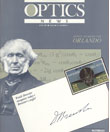Feature Articles
Would Brewster recognize today's Brewster angle?
The oldest and simplest way of treating light is in terms of geometrical optics, and, over the centuries, it has sufficed to explain most practical applications. Perhaps the first systematic and intensive studies were conducted by the Arab mathematician and optician Abu Ali Al-Hasan Ibn Al-Haytham (b.c. 965 Basra, Iraq; d. 1039 Cairo, Egypt), whose work has been commemorated on the Pakistani stamp shown on the cover. In his treatise translated into Latin in 1270, Alhazen, as he became known to medieval Europe, theorized on various issues in optics: reflection, refraction, mirrors and lenses, aberrations, rainbows, and atmospheric refraction. Most notably, he correctly deduced that light from the object seen comes to the eye.
by Akhlesh LakhtakiaOSA part of national standards writing effort
The Optical Society's Engineering Council is taking an increasing interest in optical standards. A recent report prepared for the Council suggests, among other things, that a national group concerned with optical standards be established to review and write domestic optical standards. The report also recommends that this group be a member of ANSI.
by Robert E. ParksAn engineering achievement: The first transoceanic lightwave system
After a decade of intensive design and engineering on an international scale, the world's first transoceanic lightwave system was initiated between Europe and North America last December by AT&T, British Telecom, and France Telecom. The system represents the first link in the Worldwide Intelligent Network that will connect the telecommunications networks of Europe and North America with the Far East. This system— known as TAT-8, since it is the eighth transatlantic telecommunications cable system—represents both the culmination of the hard and focused efforts of scientists and engineers from many disciplines, as well as just the beginning of an era in international telecommunications that will offer new and exciting opportunities for lightwave technology.
by Suzanne R. NagelMaterials for nonlinear optical waveguides
Low power nonlinear optics opens up a wide range of applications for the generation of new frequencies and the control of light by light. By using light-guides, the typical optical powers required for nonlinear optical devices are in the 100 mW -- 100 W range. The problem is that even this four orders of magnitude improvement over bulk nonlinear optics is not enough for most upcoming applications that will be based on semiconductor lasers. To reduce nonlinear optical powers to the 1 -- 100 mW range requires new materials.
by R.H. Stolen and G.I. Stegeman


![A multiplexed image of a human tonsil acquired. [NIAID] using the iterative bleaching extends multiplexity (IBEX) method.](https://opnmedia.blob.core.windows.net/$web/opn/media/images/articles/2024/0424/departments/202404-cover-web.jpg?ext=.jpg)
